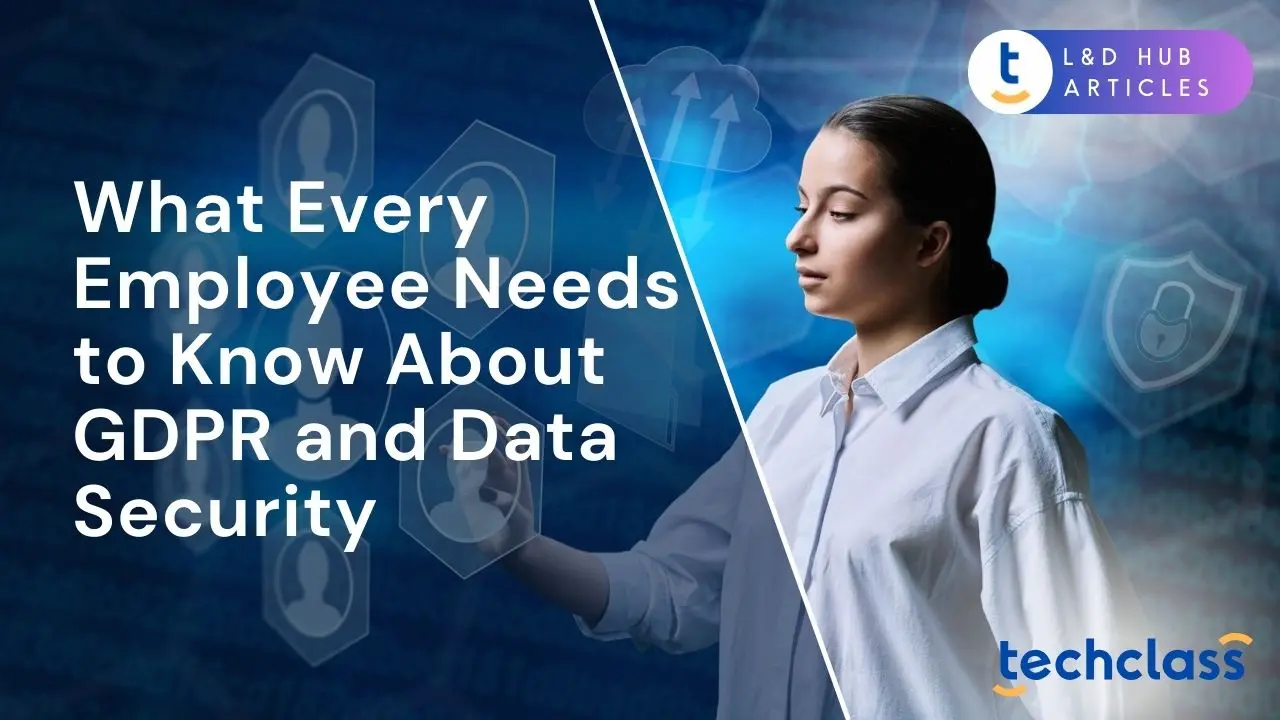
Data breaches and privacy violations aren’t just IT problems; they’re business problems that affect every employee. The European Union’s General Data Protection Regulation (GDPR) has set a global standard for personal data protection, imposing strict rules and severe penalties for non-compliance (fines can reach up to 4% of worldwide annual revenue for serious violations). These high stakes mean that protecting data is everyone’s responsibility, not just a concern for lawyers or IT staff. Studies have found that human error is a factor in the vast majority of data breaches; 95% of breaches involve mistakes by individuals. Whether it’s clicking on a phishing email or mishandling sensitive information, employees’ everyday actions have a huge impact on data security.
Modern organizations handle volumes of personal and confidential data, from customer contact details to employee records. GDPR defines “personal data” broadly as any information related to an identified or identifiable person; this can include names, emails, phone numbers, IDs, or even indirect identifiers like online user IDs. This means nearly everyone in a company deals with personal data in some form, and thus everyone must safeguard it. Beyond legal compliance, maintaining strong data protection practices helps preserve customer trust, protect the company’s reputation, and prevent costly breaches. This article will explain the GDPR basics and practical data security measures every employee, from HR and marketing to finance and operations, needs to understand.
By being aware of GDPR requirements and following data security best practices, employees can help their organizations avoid penalties and foster a privacy-conscious culture. The sections below provide an overview of key points: from understanding what GDPR is, to everyday security habits, consequences of non-compliance, and how to build a strong data protection culture in the workplace.
GDPR at a Glance: The General Data Protection Regulation (GDPR) is a landmark data privacy law that took effect in 2018, revolutionizing how organizations worldwide must handle personal information. GDPR’s reach is broad; it applies to any organization that processes personal data of people in the EU, regardless of where the organization is located. For businesses, this means strict obligations on how personal data is collected, stored, used, and shared, intending to give individuals greater control over their information. Employees should understand that GDPR isn’t just bureaucratic red tape; it establishes fundamental principles of data protection, like lawfulness, transparency, data minimization, and security, that guide daily work with personal data.
What Counts as Personal Data: Under GDPR, personal data means any information relating to an identifiable natural person. This covers obvious details (names, addresses, phone numbers, emails, national IDs) and less obvious data too, things like IP addresses, location data, customer IDs, HR records, photos, and even opinions or notes about a person can all be personal data if they tie back to an individual. In short, if you handle information that can identify someone (directly or indirectly), you’re handling personal data. Every employee should be mindful that the data they work with, whether it’s a client’s email address, a job applicant’s resume, or a colleague’s schedule, may be protected under GDPR. Treating such data with care is not only a legal duty but also an ethical one.
Individual Rights and Transparency: GDPR grants several rights to individuals (called “data subjects”) regarding their data. While employees may not need to memorize all of these rights, they should be aware of a few key examples: individuals have the right to access their data held by a company, the right to request corrections of inaccuracies, and even the right to request deletion of their data in certain circumstances (the “right to be forgotten”). People can also object to certain processing or ask to restrict it. What this means for employees is that if you receive a request from a customer or employee about their data, for example, asking “What information do you have about me?”, you must follow your organization’s procedures to handle it promptly and correctly. Being transparent and responsive to such requests isn’t just the job of the privacy officer; often, it involves front-line staff like HR professionals or customer service teams. Make sure you know the internal process for escalating data subject requests and never ignore or improperly handle these inquiries.
Accountability: GDPR also introduces an accountability principle; companies must be able to demonstrate compliance. This often involves keeping records of data processing and following internal policies. As an employee, you might wonder how this affects you. One way is that you may be required to follow certain protocols (like obtaining consent using approved forms or completing privacy checklists for new projects) to help the company document its compliance. Additionally, many organizations appoint a Data Protection Officer (DPO) or other responsible person; know who this is in your company because they are a point of contact for any privacy concerns or questions you might have.
It’s easy to assume that data security is the IT department’s job. In reality, every employee is a potential guardian or weak link in the security chain. Most data breaches are not the result of ultra-sophisticated hacks, but rather stem from everyday human errors. Recent research showed that 95% of data breaches involved some form of human mistake or oversight. This means that the emails we send, the links we click, and the documents we handle on a daily basis could determine whether or not a breach occurs. For example, an employee rushing to meet a deadline might send a file containing personal data to the wrong email recipient, an innocent mistake, but one that could constitute a reportable data breach. Similarly, clicking on a phishing email or using a weak password can give attackers a foothold into confidential systems.
Common Threats and Mistakes: All staff should be aware of common security threats and how to avoid them. Phishing scams, fraudulent messages that trick you into revealing credentials or downloading malware, are pervasive. Many employees are overconfident in spotting phishing attempts: in one survey, 86% believed they could identify a phishing email, yet nearly half admitted to falling for phishing scams. The lesson is to stay cautious and follow security training: double-check sender addresses, be wary of urgent or suspicious requests, and when in doubt, consult IT. Regular, role-specific Cybersecurity Training can reinforce these habits, helping employees better recognize phishing attempts, manage sensitive data securely, and reduce the likelihood of costly mistakes. Other frequent issues include losing devices or documents (e.g. leaving a laptop or USB drive with personal data on a train) and improper data sharing (like using personal cloud accounts or USB sticks against policy). Even something as simple as not locking your computer screen when you walk away can lead to unauthorized access.
Insider Risks: Not all risks come from outside hackers; some come from within, through either malicious intent or plain carelessness. A disgruntled employee might intentionally leak data, but far more often, breaches are accidental, for instance, an employee mishandles data because they’re fatigued, rushed, or unaware of proper procedure. In fact, internal mistakes have been on the rise, with many organizations reporting increases in data leaks due to employee error. This is why security awareness must be continuous and built into the company culture. Colleagues should remind each other of best practices, and everyone should feel responsible for speaking up if they notice a potential security lapse.
Locking the Digital Doors: Just as you wouldn’t leave the office door unlocked at night, don’t leave digital “doors” open. Basic cyber hygiene applies to all employees: use strong, unique passwords (and never share them), enable two-factor authentication when available, and keep your devices and apps updated to patch vulnerabilities. Be cautious with portable storage like USB drives, use encrypted drives if absolutely necessary, and never transport sensitive data unencrypted. GDPR actually expects organizations to use “state of the art” security measures like encryption for personal data wherever possible. That means if your role involves handling personal data files, you should ensure you’re using approved, secure tools (for example, an enterprise cloud storage instead of a personal USB).
Following Policies and Reporting Incidents: Every company should have internal security and data protection policies, and as an employee, you need to know and follow them. These guidelines might cover how to classify data, how to share it safely, and what cannot be done (e.g. policy might forbid copying data to unencrypted USB sticks, as was the case at Heathrow Airport). If you’re unsure about a procedure, ask for guidance rather than improvising. Equally important is knowing how to report a security incident or data breach. GDPR requires that data breaches be reported to authorities within 72 hours in many cases. Your organization likely has an internal protocol: who to inform first (e.g. IT security team or DPO), what details to provide, etc. Do not hesitate or delay if you suspect a data breach, quick reporting can significantly reduce the damage. Unfortunately, some employees hesitate to report issues, sometimes because they’re not sure how or fear getting blamed. In a recent survey, 38% of employees who hesitated to report security risks said it was because they “did not know how to” report them. To combat this, companies should foster a no-blame culture around reporting. As an employee, remember that hiding a mistake can be far more costly than promptly reporting it. You will protect your organization (and possibly its customers) by raising the alarm quickly if something goes wrong.
So, what practical steps can employees take to ensure they handle data correctly and securely? Below are some key best practices every employee should integrate into their daily work routines:
By following these practices, employees significantly reduce risks. Moreover, well-informed employees can even act as the first line of defense, spotting suspicious activities or potential compliance issues early and notifying the right people. Remember, GDPR compliance and data security are ongoing processes, not one-time tasks. Staying vigilant day-to-day is key to protecting personal data.
What happens if things go wrong? Understanding the impact of a data breach or GDPR violation underscores why all the precautions are worth it. First, there are the legal and financial penalties. Under GDPR, regulators can impose hefty fines on organizations that fail to protect data or violate individuals’ rights. The maximum fines can be €20 million or 4% of the company’s global annual turnover, whichever is higher. This isn’t just a theoretical threat, numerous companies have faced multi-million euro fines for breaches or non-compliance. For example, large enterprises like British Airways and Marriott have been fined millions for failing to secure customer data. Even giants like Amazon and Google have incurred record-breaking penalties under privacy laws.
It’s not only big multinationals at risk. Smaller incidents can also lead to fines. Consider a real-world case: London’s Heathrow Airport was fined £120,000 by the UK Information Commissioner’s Office after an employee lost an unencrypted USB stick containing personal data. The USB, which held sensitive information (including names, birthdates, and passport numbers of staff and even potentially security details), was found by a random passerby. Because the data on it wasn’t encrypted or protected, unauthorized people were able to access the information, a clear violation of GDPR’s requirement to keep personal data secure. The investigation revealed deeper issues too: copying data to unprotected USB drives was widespread in the organization, and alarmingly only about 2% of Heathrow’s employees had received data privacy training at that time. This case illustrates how one employee’s mishandling of data can expose an organization to regulatory action, and how lack of training can exacerbate the problem. Heathrow got off relatively lightly (the fine was limited under the old UK law in effect at the time), but under GDPR the penalties could have been far more severe, up to £17 million in their case.
Beyond fines, the fallout from a breach can include:
In summary, the cost of failing at data protection far exceeds the cost of doing it right. A single incident can set off a chain reaction of consequences: regulatory fines, customer churn, PR crises, and internal turmoil. This is why executives like CISOs and business owners are so keen on strengthening data security, but they need every employee on board. Each person in the company can help prevent these outcomes by being diligent with data. Conversely, one careless moment by an individual could trigger serious repercussions. The next section discusses how organizations can support employees in this mission and create a culture that prioritizes privacy and security.
Achieving GDPR compliance and robust data security is not a one-time checklist, but a continuous organizational effort. For employees to consistently do the right thing, companies must foster a culture where privacy and security are ingrained values. This starts with education and awareness. Every employee, from new hires to top management, should receive training on GDPR and data protection practices. Importantly, this training shouldn’t be a dull, one-off lecture during onboarding. Given the evolving nature of threats and regulations, regular refresher sessions and updates are essential to keep everyone sharp. For example, initial training might cover the basics, what GDPR is, what personal data and data subject rights are, how to handle data safely, while ongoing awareness activities can reinforce key lessons (like reminding people to lock screens, or how to spot new phishing trends). In fact, integrating periodic reminders (posters in the office, infographics in internal newsletters, etc.) helps keep best practices fresh in mind.
Leadership and Example: Building a privacy-first culture requires buy-in at all levels. Leaders and managers play a crucial role by setting an example. If a manager consistently follows privacy protocols, like properly securing files and respecting data minimization, their team is more likely to mirror those behaviors. Leadership should also communicate that data protection is a strategic priority. When employees see that management genuinely cares about security (and not just as lip service), they understand that compliance is part of the company’s identity. Encouragingly, many companies now include data security and privacy KPIs as part of performance evaluations or team goals, underscoring that everyone is accountable.
Empowering Employees through Training: Quality training goes beyond reciting rules, it should empower employees with practical skills and confidence to handle data correctly. Interactive sessions, real-life case studies, and role-specific guidance can make training more effective. For instance, the marketing team might get examples on how to run GDPR-compliant campaigns (obtaining proper consent for mailing lists, etc.), while HR might focus on handling employee data and responding to subject access requests. A well-trained workforce is better equipped to identify and mitigate risks, reducing the chance of accidental breaches. Training also ensures everyone knows how to react if something goes wrong. As discussed, employees should be clear on the internal incident reporting process. Drills or tabletop exercises can be useful, for example, simulating a phishing attack or a lost laptop scenario to practice the response. The goal is to make sure that if an incident occurs, employees react swiftly and correctly (e.g. immediately reporting to IT, securing any exposed data, etc.), in line with GDPR’s breach response requirements.
Communication and Openness: Encourage an environment where employees feel comfortable asking questions about data handling or raising concerns. Sometimes staff might notice a potential security gap or have an idea to improve privacy, but they stay silent fearing it’s not their place. Break down that barrier by treating security as a shared mission. Some organizations establish “privacy champions” or security ambassadors within departments, staff who have extra training and can act as go-to persons for colleagues’ questions. This can be very effective in large companies, making privacy support more accessible on the ground. Also, celebrate good security behavior: if someone reports a phishing email that leads to averting an incident, recognize that initiative. Positive reinforcement helps motivate everyone to stay alert.
Policies and Enforcement: While culture is about mindset, it must be backed by clear policies and enforcement. Ensure that there are up-to-date, user-friendly policies on data protection, and that employees know where to find them. Policies might cover topics like acceptable use of devices, data classification levels, encryption requirements, social media guidelines, etc. These shouldn’t sit on a shelf, incorporate them into training and daily operations. Crucially, enforce the rules fairly and consistently. If certain risky behaviors (say, using unauthorized cloud services or ignoring software updates) are prohibited, there need to be follow-ups when they occur. Enforcement doesn’t always mean punishment; it can be coaching or additional training. However, employees should understand that data security policies are serious, not optional suggestions.
Learning from Incidents: If a breach or near-miss does happen, use it as a learning opportunity (once the immediate issue is resolved). Conduct a post-mortem to understand not just what technical failure happened, but also what behavioral or process gap allowed it. Then refine training and processes accordingly. For example, if an incident occurred because an employee was fooled by a very convincing phishing email, the organization might decide to intensify phishing awareness efforts or implement an email warning system for external senders. The idea is to continuously improve defenses with each lesson learned, and to share those lessons organization-wide so everyone benefits.
Building a culture of privacy and security doesn’t happen overnight, but it’s one of the best defenses against data breaches. When everyone from the CEO to entry-level staff knows the importance of data protection, understands the risks, and feels personally responsible for guarding data, the company is far less likely to slip up. Moreover, a strong internal culture will impress external stakeholders, clients and partners prefer to work with organizations that visibly take data protection seriously. In the long run, investing in employees’ awareness and skills is investing in the organization’s resilience and trustworthiness.
In today’s data-driven world, regulations like GDPR are a reminder that privacy and security are fundamental to doing business. For HR professionals, CISOs, business owners, and enterprise leaders, one of the wisest moves is to empower your people, your employees, with the knowledge and tools to protect data. After all, technology alone cannot safeguard sensitive information; it’s the choices and habits of individuals that often make the decisive difference. By educating employees on GDPR and fostering an environment where everyone takes ownership of data security, organizations create a powerful human firewall against breaches and compliance missteps.
For every employee, from any industry, the key takeaway is this: you are an important link in the chain of data protection. Understanding the basic do’s and don’ts of GDPR and data security isn’t just about avoiding fines, it’s about respecting the trust that customers, clients, and colleagues place in us to handle their information with care. It’s about knowing that the actions you take (or fail to take) can either keep data safe or accidentally put it at risk. The good news is that with a bit of awareness and diligence, you can significantly contribute to your organization’s privacy efforts. Small habits, like double-checking a recipient before sending data or promptly reporting a lost device, can have a big impact in preventing incidents.
Ultimately, GDPR compliance and strong data security come down to a shared responsibility. When companies invest in their employees through training and clear guidance, and when employees embrace that responsibility in their daily work, the result is a robust privacy-first culture. This culture not only helps avoid penalties, but also builds credibility and trust, a competitive advantage in any field. By knowing what GDPR expects and committing to best practices, every employee becomes a guardian of the organization’s integrity and the privacy of the individuals whose data is in our care. Empowered with the right knowledge and mindset, employees are truly the first line of defense in data security.
Under GDPR, personal data includes any information that can directly or indirectly identify a person—such as names, email addresses, IPs, or employee records. Even indirect identifiers like user IDs can count if they relate to an individual.
Data breaches often occur due to human error, not advanced hacking. Employees can prevent violations by following secure practices—like using strong passwords, recognizing phishing, and handling data carefully.
Violations can lead to fines up to €20 million or 4% of global revenue. Organizations also face reputational damage, business disruption, legal liability, and loss of client trust.
Employees should use secure tools, apply data minimization, double-check email recipients, stay updated on phishing tactics, and report any suspicious activity or potential breaches immediately.
By offering ongoing training, fostering open communication, encouraging reporting without blame, involving leadership, and reinforcing policies through daily practices and real-world scenarios.


